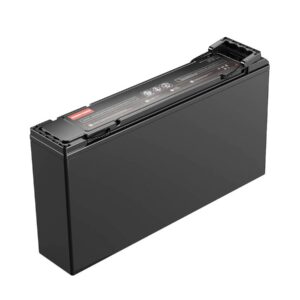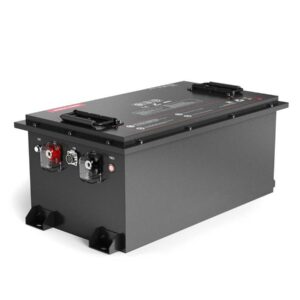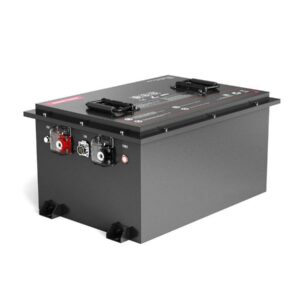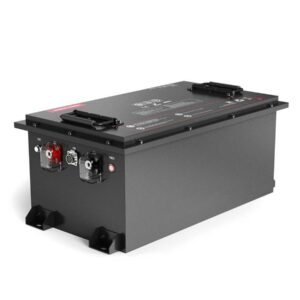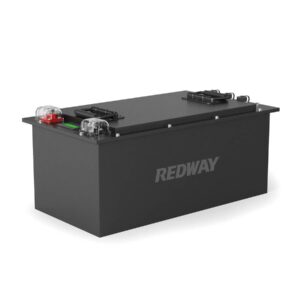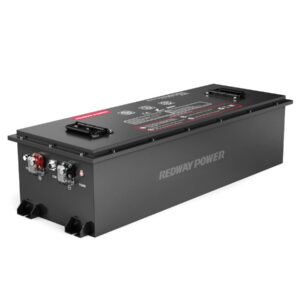Description
Overview
The 48V 150Ah LiFePO4 Battery delivers 7.2kWh industrial-grade power for demanding mobility applications. As a professional lithium battery manufacturer, we engineer this solution with 6,000+ cycle life and IP67 protection, offering exceptional value for OEM partners in electric vehicles and material handling equipment.
Key Features
- Ultra-High Capacity: 7.2kWh energy storage with 150Ah output
- Extreme Power Delivery: 200A continuous/400A peak discharge
- Military-Grade Protection: IP67 metal casing (55kg weight)
- Smart Monitoring: Bluetooth APP with optional LCD display
- Scalable Configuration: 4S4P connection capability
Technical Specifications
- Dimensions: 510×410×235mm
- Voltage Range: 37.5V-54.75V (48V nominal)
- Temperature Range: -20°C~60°C operation
- Cycle Life: >6,000 cycles at 80% DOD
- Certifications: UL, IEC, CE, UN38.3 (global compliance)
Advanced Protection System
- 16+ BMS safeguards including temperature/voltage protection
- Active cell balancing for optimal performance
- Optional self-heating for cold environments
- Multiple communication protocols (RS485/CAN-bus)
Customization Options
- Branding: Custom silkscreen/laser logos
- Connectivity: 4G/GPS/WiFi anti-theft systems
- Cooling: Fan/heat sink configurations
- Special Features: Solar MPPT integration
Industry Applications
- Electric vehicles (golf carts, rickshaws, scooters)
- Material handling (AGVs, forklifts, cleaning machines)
- Marine systems (trolling motors)
- Renewable energy storage
How Does a 48V 150Ah LiFePO4 Battery Improve Golf Cart Performance?
How does a 48V 150Ah LiFePO4 battery improve golf cart performance? This battery offers high energy density, a long cycle life exceeding 3000 cycles, and advanced safety features through its built-in battery management system (BMS). It supports fast charging, has a lightweight design, and operates stably across various temperatures, making it an ideal upgrade over traditional lead-acid batteries for golf carts and electric vehicles.
What are the detailed specifications of the 48V 150Ah LiFePO4 golf cart battery?
The 48V 150Ah LiFePO4 golf cart battery typically has a nominal voltage of 51.2V and a rated capacity of 150Ah, providing around 7.68 kWh of energy storage. It uses a 16S cell configuration with an integrated BMS that supports CAN, RS485, or Bluetooth communication for real-time monitoring. The battery weighs between 60 and 71 kg and measures approximately 650mm x 325mm x 180-262mm. It supports continuous discharge currents of 150-200A and pulse discharges up to 300-500A, with a cycle life exceeding 3000 cycles at 80% depth of discharge.
How does the battery management system (BMS) protect and optimize the battery?
The BMS safeguards the battery by preventing overcharge, over-discharge, short circuits, over-current, and extreme temperature damage. It balances individual cells to maximize capacity and lifespan and provides real-time data via Bluetooth or CAN communication. This ensures safe operation, prevents damage, and optimizes performance during charging and discharging cycles.
What are the recommended charging and discharging parameters?
Charging voltage peaks between 54.75V and 58.4V, with maximum charge currents ranging from 30A to 75A depending on the model. Discharge cut-off voltages are around 37.5V to 44.8V. Continuous discharge currents are safely maintained between 150A and 200A, with pulse discharges up to 300-500A for short bursts. The operating temperature range for charging is 0°C to 55°C, and for discharging, it is -20°C to 65°C, ensuring reliable performance in diverse climates.
How long does the 48V 150Ah LiFePO4 battery last in terms of cycle life?
These batteries typically offer over 3000 to 4000 full charge-discharge cycles at 80-100% depth of discharge, significantly outperforming lead-acid batteries, which usually last 300-600 cycles. This longevity reduces replacement frequency and total cost of ownership for golf cart users.
How does the battery perform under various temperature conditions?
The battery operates efficiently between -20°C and 65°C for discharging and 0°C to 55°C for charging. It includes low temperature cut-off protections to prevent charging below freezing, preserving battery health. This wide temperature tolerance allows golf carts to function reliably in diverse environments.
What are the physical dimensions and weight of the battery?
Typical dimensions range from 650mm (length) x 325mm (width) x 180-262mm (height), with weights between 60 kg and 71 kg depending on the casing and configuration. The compact and lightweight design compared to lead-acid batteries facilitates easier installation and better vehicle handling.
What advantages does the LiFePO4 battery offer compared to lead-acid batteries?
LiFePO4 batteries provide higher energy density, longer cycle life, faster charging, and lighter weight. They are safer with no risk of fire or explosion, require less maintenance, and have a lower environmental impact due to their non-toxic chemistry. Their stable voltage output enhances golf cart performance and reduces energy costs by up to 35%.
How does this battery enhance golf cart performance and energy efficiency?
The 48V 150Ah LiFePO4 battery delivers consistent power with high discharge rates, enabling better acceleration and longer driving range—up to 70 miles per charge. Its advanced BMS and smart features like mobile app monitoring optimize energy use and extend battery life, making golf carts more reliable and cost-effective.
How do you install and maintain the 48V 150Ah LiFePO4 golf cart battery?
Installation involves securely mounting the battery using its designed brackets, connecting terminals (M6 or M8), and integrating with the golf cart’s controller system. Maintenance is minimal due to the battery’s built-in BMS and robust design; regular inspections for terminal cleanliness and firmware updates via Bluetooth or CAN are recommended to ensure optimal performance.
What environmental benefits does using a LiFePO4 battery provide?
LiFePO4 batteries are eco-friendly, containing no heavy metals like lead or cadmium, reducing hazardous waste. Their long lifespan minimizes battery disposal frequency, and their high efficiency reduces energy consumption. These factors contribute to a smaller carbon footprint compared to traditional lead-acid batteries.
How does mobile app monitoring improve battery management and user experience?
Mobile app connectivity allows users to monitor state of charge (SOC), temperature, voltage, and health status in real-time. This proactive insight helps prevent battery misuse, schedules maintenance, and extends battery life. The convenience of remote monitoring enhances user confidence and operational efficiency.
Battery Specification Comparison Chart
| Feature | Typical Value | Notes |
|---|---|---|
| Nominal Voltage | 48V (51.2V nominal) | Standard for golf carts |
| Capacity | 150Ah | Deep cycle capacity |
| Energy | ~7.68 kWh | Total stored energy |
| Cycle Life | 3000-4000 cycles | At 80% depth of discharge |
| Continuous Discharge | 150-200A | Sustained current |
| Pulse Discharge | 300-500A (seconds) | Short bursts |
| Weight | 60-71 kg | Lightweight vs lead-acid |
| Dimensions (LxWxH) | ~650 x 325 x 180-262 mm | Compact form factor |
| Operating Temp (Charge) | 0°C to 55°C | Safe charging range |
| Operating Temp (Discharge) | -20°C to 65°C | Wide discharge range |
| Ingress Protection | IP65 – IP67 | Dust and water resistance |
















